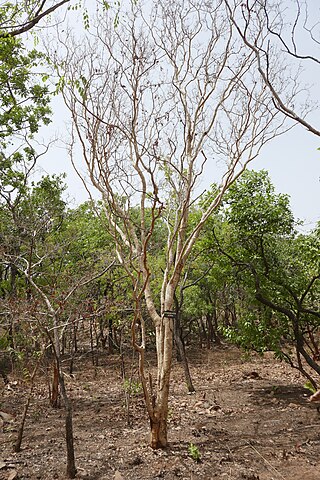
Trillium is a genus of about fifty flowering plant species in the family Melanthiaceae. Trillium species are native to temperate regions of North America and Asia, with the greatest diversity of species found in the southern Appalachian Mountains in the southeastern United States.

Tulsa International Airport is a civil-military airport five miles (8 km) northeast of Downtown Tulsa, in Tulsa County, Oklahoma, United States. It was named Tulsa Municipal Airport when the city acquired it in 1929; it received its present name in 1963. While Tulsa International Airport only serves domestic destinations, it is still an international airport since it has customs and border patrol facilities.

Xylosma is a genus of flowering plants in the family Salicaceae. It contains around 100 species of evergreen shrubs and trees commonly known as brushhollies, xylosmas, or, more ambiguously, "logwoods". The generic name is derived from the Greek words ξύλον (xylon), meaning "wood, tree", and ὀσμή (osmé), meaning "smell", referring to the fragrant wood of some of the species. The Takhtajan system places it in the family Flacourtiaceae, which is considered defunct by the Angiosperm Phylogeny Group.

Antidesma is a genus of tropical plant in the family Phyllanthaceae formally described by Linnaeus in 1753. It is native to tropical Africa, S + E + SE Asia, Australia, and various oceanic islands. The greatest diversity occurs in Southeast Asia.

Cynometra is genus of tropical forest trees with a pantropical distribution. It is particularly important as a forest component in west Africa and the neotropics. Cynometra alexandri (muhimbi) is a familiar timber tree of central and east Africa. The genus is a member of the subfamily Detarioideae. It has been suggested that Cynometra is polyphyletic and is in need of revision. In 2019, beside description of 4 new species, Aleksandar Radosavljevic suggested that the species formerly recognized as Maniltoa should be included in this genus and some of the mainland tropical African species excluded from this genus because of their jointed pedicels and dehiscent fruits.

Hymenocardia acida is a plant of the family Phyllanthaceae native to tropical Africa. It is a small tree that grows to 10 m tall. Occurs in the Guinea and Sudanian savannah zones and deciduous woodland, from Senegal eastwards to Ethiopia and southwards reaching Zimbabwe.
Alexei Ivanovich Vvedensky was a Russian botanist.

Tricliceras is a genus of flowering plants belonging to the family Passifloraceae. Its native range is Tropical Africa, Southern Africa, Madagascar.
Weddellina is a monotypic genus of flowering plants belonging to the family Podostemaceae. It only contains one known species, Weddellina squamulosa.
Marathrum is a genus of flowering plants belonging to the family Podostemaceae.

Rhyncholacis is a genus of flowering plants belonging to the family Podostemaceae.
Oserya is a genus of flowering plants belonging to the family Podostemaceae.
Quiina florida is a species of tree in the Ochnaceae family.
Zanthoxyloideae is a subfamily of the family Rutaceae.
Arboa berneriana is a shrub or tree that grows in the wet tropics of northern Madagascar. It has varying ranges of colors from yellow to orange to red.
Tricliceras auriculatum is an annual herb native to Nampula Mozambique.
Tricliceras brevicaule is a perennial herb native to Africa.There are two varieties of T. brevicaule:brevicaule and rosulatum. The varieties can be identified by the shape of their petals. Variety brevicaule has petals with pointed ends, while rosulatum has rounded ends. T. brevicaule var. brevicaule can be found in bushlands and grasslands of Kenya, Tanzania, Mozambique and Zambia. T. brevicaule var. rosulatum can be found in the forests, woodlands, and roadsides of Kenya, Tanzania, Malawi, Mozambique and Zambia.
Tricliceras elatum is a distylous herb native to northern Mozambique, Africa. As of 2020, T. elatum has been classified as endangered.







